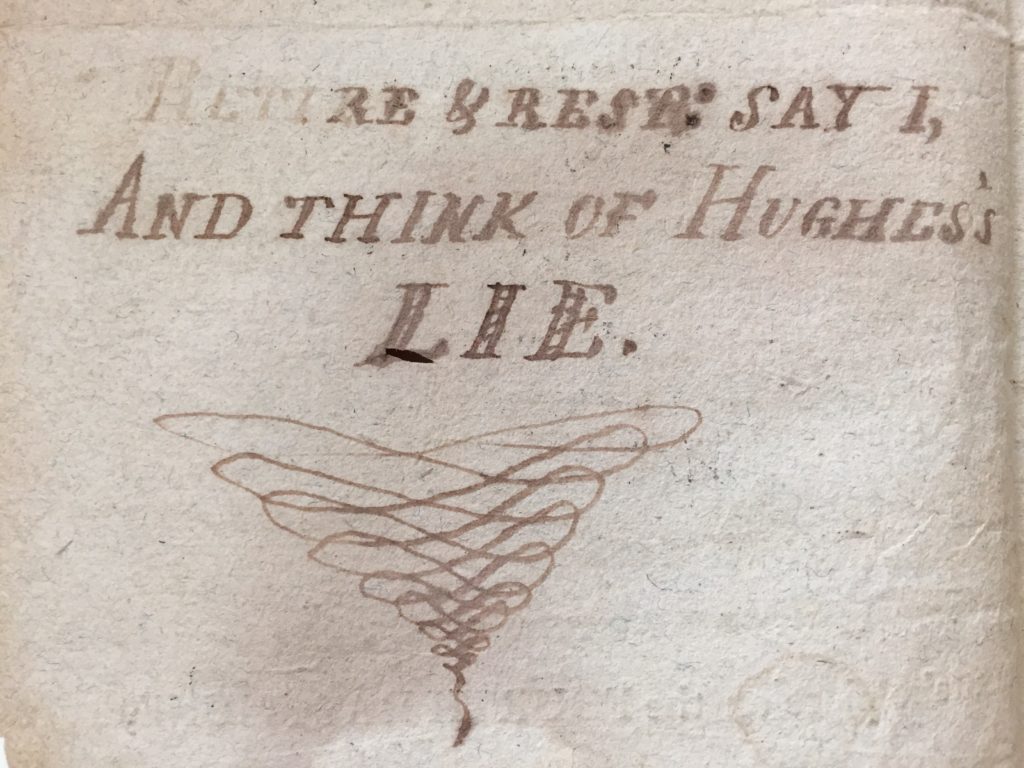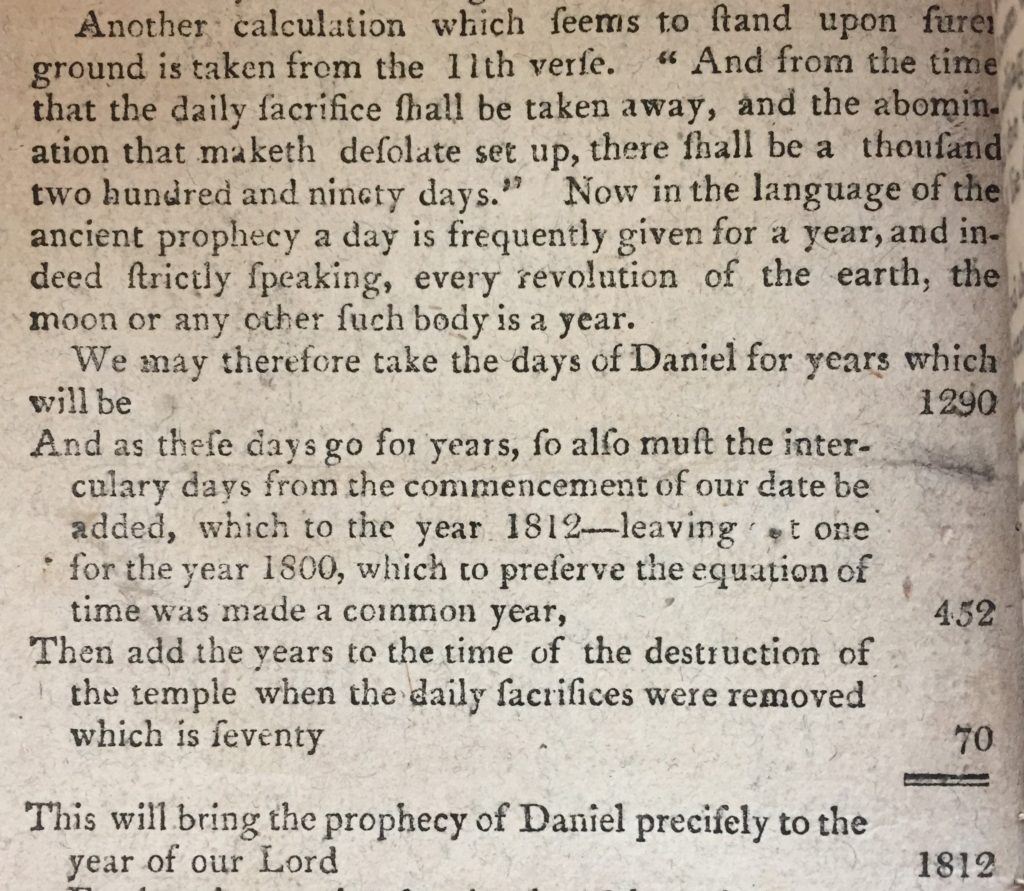
“I saw the gathering tempest and heard its dreadful roarings, which seemed to me the roaring and burstings of ten thousand canons at once. Then I saw the trees of the forest torn by the violence of the winds, and dashed against each other, and against everything that stood before them, and houses and rocks and hills torn from their foundations, and shattered into atoms, and blown about like the dust of the earth.” According to Nimrod Hughes, this is the fate that awaited the world on June 4, 1812, along with the destruction of one-third of mankind. In the wake of a bright and long-lasting comet, earthquakes, and an eclipse, Hughes’s prophecies fell onto a population primed to believe in any new natural catastrophe.
Hughes’s prophetic pamphlet was titled A solemn warning to all the dwellers upon earth, given forth in obedience to the express command of the Lord God, as communicated by Him, in several extraordinary visions and miraculous revelations, confirmed by sundry plain but wonderful signs, unto Nimrod Hughes, of the county of Washington, in Virginia, upon whom the awful duty of making this publication, has been laid and enforced; by many admonitions and severe chastisements of the Lord, for the space of ten months and nine days of unjust and close confinement in the prison of Abingdon, wherein he was shewn, that the certain destruction of one third of mankind, as foretold in the Scriptures, must take place on the fourth day of June, in the year of our Lord 1812. In it, Hughes claimed to have received apocalyptic visions from God during a recent imprisonment. A Solemn Warning was a bestseller, and many editions were published from mid-1811 into 1812, including at least six in English and two in German. On October 25, 1811, the Carlisle Gazette noted that “[Nimrod Hughes’s] prophecies are eagerly sought after from every corner, and the printers are hardly able to keep pace with the uncommon demand.” The popularity of this pamphlet eventually spawned a massive assault against Nimrod Hughes and his prophetic pretensions in the press.

Some early newspaper articles about Nimrod Hughes and A Solemn Warning tried to simply present a balanced view of the available information. Kline’s Weekly Carlisle Gazette in Carlisle, Pennsylvania, published a communication from “a layman” in Baltimore describing a terrible hail storm in Alexandria, Virginia, ten days after its citizens mocked Hughes, concluding with the observation, “since this period the reputation of Nimrod Hughes, has greatly augmented in the public estimation; but as to his prophecies, (without hazarding an opinion) we leave them, and him with his motives to settle with his maker.”

Most writers, however, openly attacked both Hughes and the credulity of his readers. One of the earliest assaults on Hughes’s character appeared in a letter from William M’Kee to his brother on November 4, 1811, which received wide reprinting. In it, M’Kee describes Hughes as “one of the greatest villains I ever new [sic].…There is no man who is acquainted with him would believe a word he says; much less have the confidence in his prophecy, and I never was more astonished than to hear that his pamphlet excited a single enquiry” (Palladium of Liberty, January 28, 1812). Newspapers printed conflicting accounts of what landed Hughes in jail, and he was alternately accused of libel, horse theft, stealing bacon, and burning a barn. When some reports claimed he had been a Methodist minister, other reports were quick to say he’d never been any such thing. In many ways, the constant attempts to pin down facts, the in-depth arguments against false prophecy juxtaposed with quick character insults, and worries about the public’s willingness to believe anything in print would be instantly familiar to anyone who spends even a small amount of time looking at contemporary news.
The descriptions of Hughes in 1811 and 1812 newspapers easily presage the character attacks prevalent in contemporary journalism. Throughout the country, Hughes was described as “the pretended prophet” (Farmer’s Repository, Charles Town, Virginia); “the imposter” (Palladium of Liberty, Morristown, New Jersey.); “the false prophet” and “an abandoned wretch,” (Long-Island Star, Brooklyn, New York); and “that villain Nimrod Hughes” and “ye who fatten on human vice, ignorance and meanness” (The Pittsburg Mercury, reprinted in The Tickler, Philadelphia, Pennsylvania). Some writers went so far as to accuse Hughes of maliciously misusing the public’s trust. “It is matter of much regret to see persons, who ought to know better, take advantage of such a period to impress the minds of the people with idle fears,” lamented an anonymous writer to the Pittsburg Mercury. Under the headline “False Prophet,” the Long-Island Star complained, “there have been four or five different prophecies since the appearance of the comet but none of them so artful, so wicked, or so dangerous as Nimrod Hughes’.” The vocabulary may have changed in modern discourse, but the sentiments are essentially the same.

When June 4, 1812, passed without any of Hughes’s predictions coming true, the papers wasted little time in pointing out the error of Hughes’s prophecies. On June 9, the American and Commercial Daily Advertiser in Baltimore reported “The 4th of June has past [sic].…[Hughes’s] prediction of the hail, and the whirlwind, and of the destruction of one-third of our species is blown to air.” The Courier in Washington, D.C., went so far as to publish a poem by one Julio Everard, which begins “Blush—ye weak deluded mortals, blush, / Ye who would believe and fear a man, / And not the words of thy all seeing God!” (The rest of the poem is equally melodramatic.) The New-England Palladium in Boston opined that believers in Hughes’s prophecy would have been better off buying lottery tickets, and the Public Advertiser in New York argued that the only apocalyptic occurrence following the publication of Hughes’s prophecy was the nomination of DeWitt Clinton for president.
I stumbled into this vicious nest of newspaper attacks after cataloging an undated, abridged edition of Hughes’s prophecy. While the outrage over Hughes’s audacity at publishing “lying prophecies” is amusing and entertaining reading to us, what truly struck me is how little the response to ridiculous news has changed in two hundred years. Aside from the medium of delivery, there isn’t much difference between a newspaper reprinting William M’Kee’s letter prefaced by their own commentary and a Facebook or Tumblr user sharing a link to an article and putting their thoughts with it. If there’s one thing exposure to the vast collection of newspapers housed at AAS has taught me, it’s that the news has changed very little throughout America’s history. So, the next time you’re rolling your eyes over an acquaintance believing a dubious news article or you’re exasperated by extended news coverage of a dubious scientific claim, remember the time Nimrod Hughes predicted the destruction of one-third of the population and was wrong.
